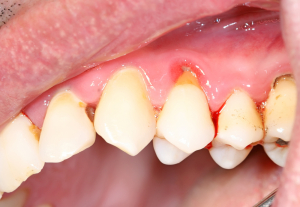Gingivitis is a common infection of the gums. The middle third of the tooth is imbedded in gingiva. Without flossing the gingiva forms pockets that are colonized with the acid forming bacteria (mutans streptococci mentioned under tooth decay above). This leads to a pH of less than 5.5 and subsequent decalcification of enamel and cementum where the gingiva has retreated and the neck of the teeth has been exposed. The next step is tooth decay and cavity formation. Chronically inflamed gingiva is called gingivitis, a painful gum disease, which can cause bleeding after minor mechanical impact such as chewing food. A lack of dental hygiene (not brushing, not flossing) leads to gingival pockets harboring even more bacteria and accelerating tooth decay. Gingivitis occurs commonly also during puberty, during menstruation, pregnancy and if a patient is on the birth control pill. Some medical conditions such as diabetes and AIDS are known to be associated with a higher incidence of gingivitis as are severe vitamin C and niacin deficiency. Patients with Crohn’s disease also are more susceptible to develop gingivitis. A severe form of acute necrotizing ulcerative gingivitis is also called a “trench mouth” or “Vincent’s infection or angina”. This can occur in smokers or debilitated persons under extreme stress. Other contributing factors are poor oral hygiene, sleep deprivation and nutritional deficiency.
Treatment of gingivitis
Gingivitis can be almost completely prevented by regular dental hygiene consisting of regular tooth brushing and flossing. By removing plaque every 6 month (in high risk conditions mentioned above more often, perhaps up to 4 times per year) the mouth flora changes into a more caries resistant flora with much less likelihood of gingivitis developing. The dentist may decide to intervene with minor surgery, if the pockets have an excessive depth, severe infection or abscess formation. More severe cases may need antibiotics and debridement by a dentist or oral surgeon.
References:
1. Suzanne Somers: “Breakthrough” Eight Steps to Wellness – Life-altering Secrets from Today’s Cutting-edge Doctors”, Crown Publishers, 2008
2. http://www.webmd.com/oral-health/dental-root-canals
3. http://www.aacd.com/whitening
4. http://www.nhs.uk/conditions/Gum-disease/Pages/Introduction.aspx
5. http://www.aae.org/patients/treatments-and-procedures/root-canals/root-canals.aspx
6. http://en.wikipedia.org/wiki/Dental_trauma
7. http://www.dailymail.co.uk/health/article-25286/The-complete-guide-cosmetic-dentistry.html







